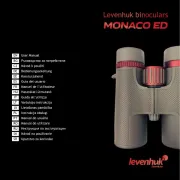Levenhuk Nelson 7x35 Manual
Læs gratis den danske manual til Levenhuk Nelson 7x35 (4 sider) i kategorien Kikkert. Denne vejledning er vurderet som hjælpsom af 13 personer og har en gennemsnitlig bedømmelse på 4.5 stjerner ud af 7 anmeldelser.
Har du et spørgsmål om Levenhuk Nelson 7x35, eller vil du spørge andre brugere om produktet?

Produkt Specifikationer
| Mærke: | Levenhuk |
| Kategori: | Kikkert |
| Model: | Nelson 7x35 |
Har du brug for hjælp?
Hvis du har brug for hjælp til Levenhuk Nelson 7x35 stil et spørgsmål nedenfor, og andre brugere vil svare dig
Kikkert Levenhuk Manualer










Kikkert Manualer
- Trebs
- Swarovski Optik
- Tevion
- CamLink
- Braun
- ExploreOne
- MAK
- Pulsar
- Night Owl
- Olympus
- Meopta
- Crivit
- Leupold
- Goview
- NEWTON
Nyeste Kikkert Manualer









